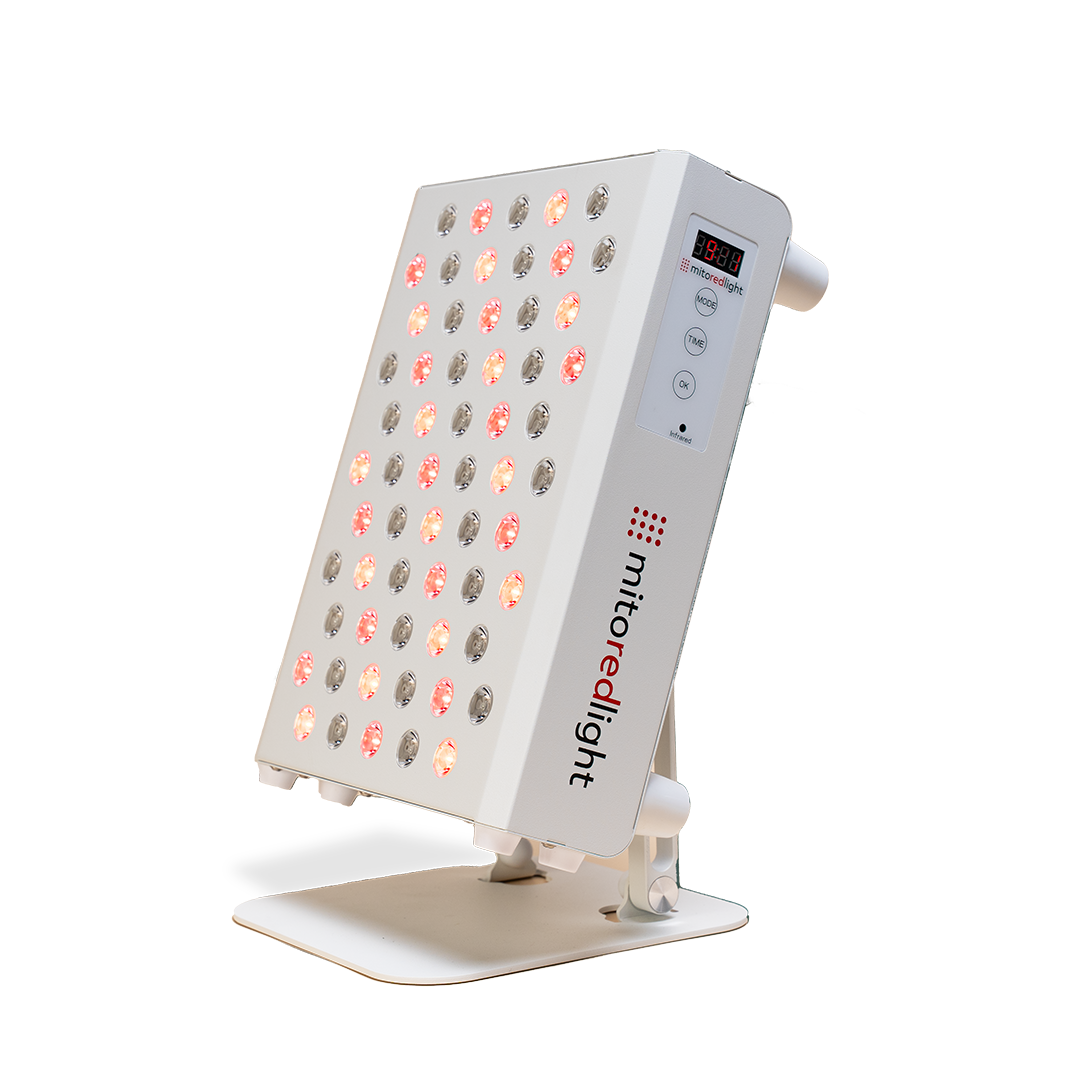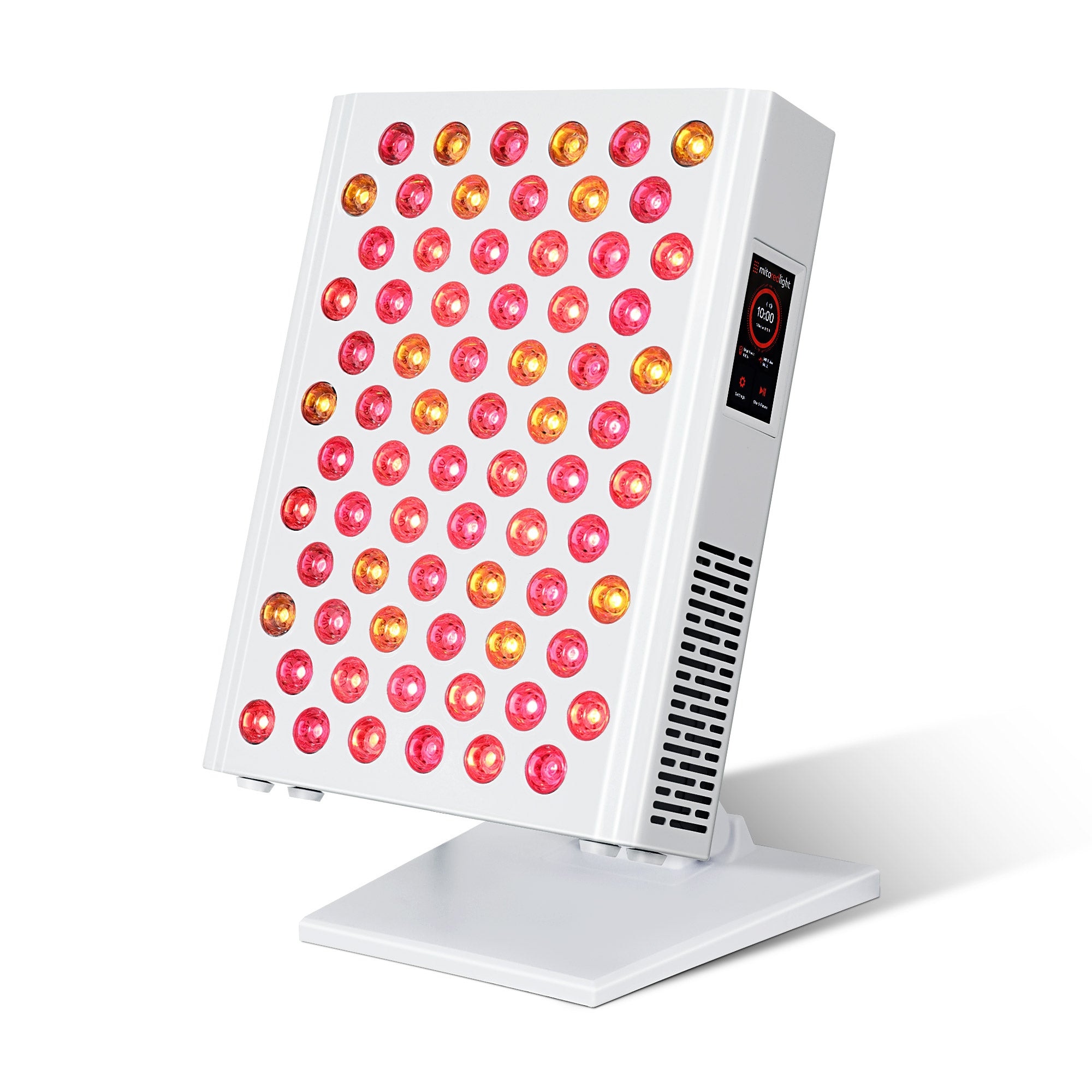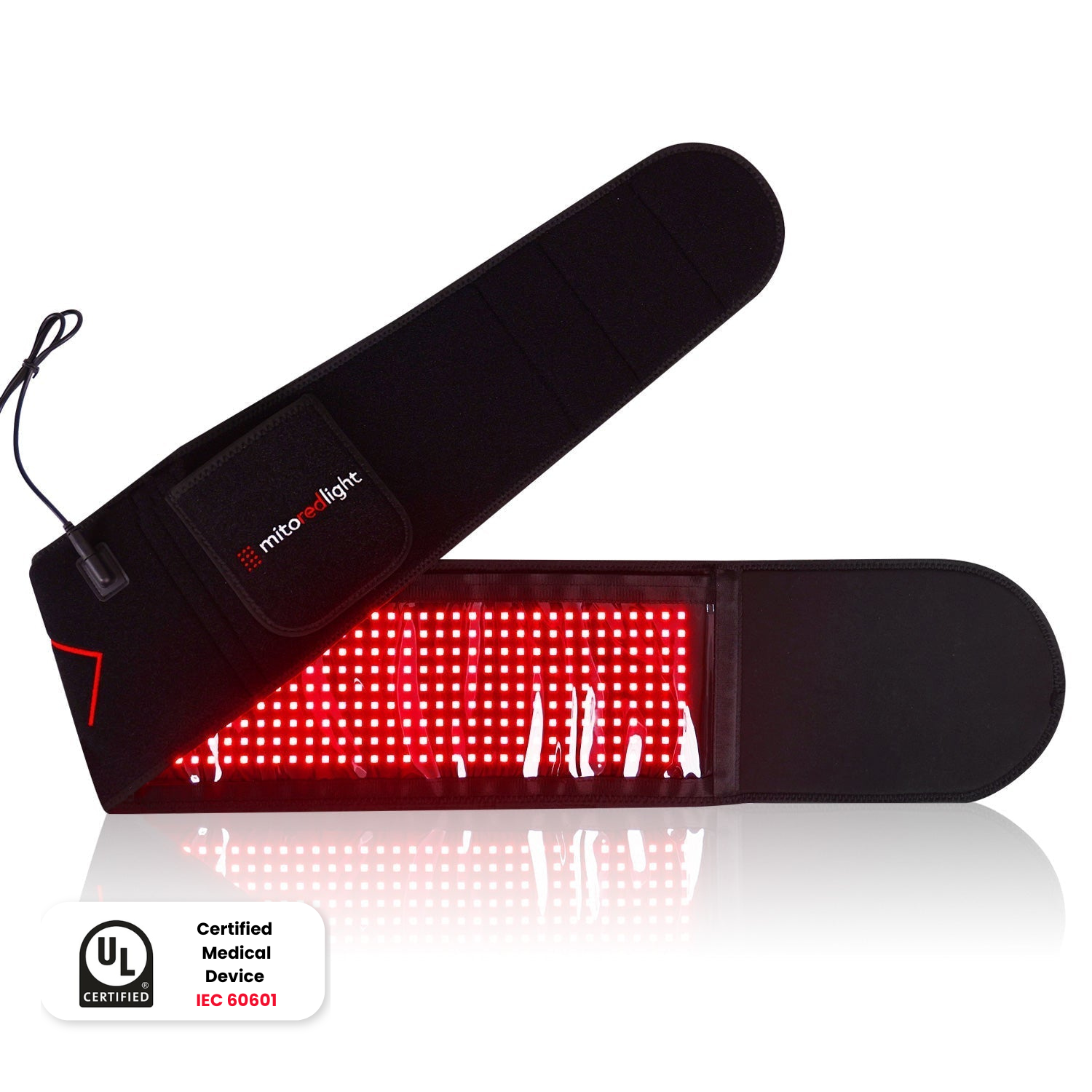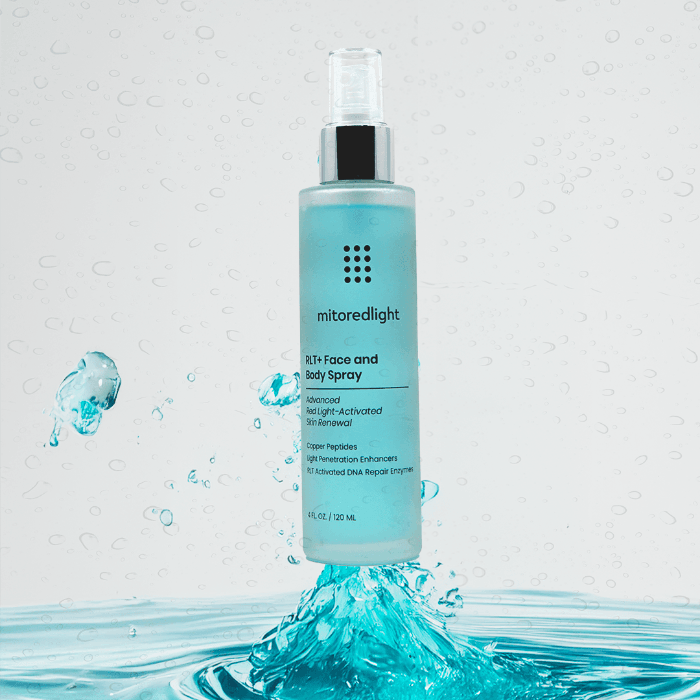DISCLAIMER: Mito Red Light devices are Class II wellness devices aimed at affecting the body through topical heating and supporting cellular function. The information provided in this article and on this site is for educational purposes only and is not intended to imply effectiveness of Mito Red Light devices for any specific application. The information provided in this article and on this site is not intended to diagnose, treat, cure, or prevent any disease, is not a substitute for consultation with a licensed medical provider and should not be construed as medical advice. Click here to read our article on potential contraindications of red light therapy..
Executive Summary
This Mito Red Light article explores the potential of red light therapy (RLT) as a supportive tool for migraine management. Migraines are complex neurological events involving nerve pathways and brain chemicals, causing severe headaches and other symptoms. RLT, using red and near-infrared light, targets cellular mitochondria to potentially enhance energy production and promote a soothing effect. While not a migraine cure, RLT may help manage triggers like stress and poor sleep by supporting overall cell function. Research on green light also suggests potential benefits for migraines. Optimizing RLT involves consistency, proper session timing, creating a relaxing environment, starting with short sessions, staying hydrated, using quality devices, combining with other management techniques, and monitoring individual responses. RLT is generally safe, with rare side effects when used correctly.
Key Takeaways:
- Migraines are complex neurological headaches with various triggers and symptoms.
- Red light therapy may support overall cell function and potentially aid migraine management.
- Research on green light therapy also suggests potential benefits for migraines.
- Optimizing RLT for migraines involves consistent, tailored use and a relaxing environment.
- RLT is generally safe when used according to guidelines.
Medically Reviewed by | Heidi Wright, BSN, RN, PCCN
At Mito Red Light, we're all about harnessing the power of light to support your well-being — but how does this apply to migraines?
Red light therapy, using specific wavelengths, helps target the body’s cells to potentially support energy and promote a soothing effect.
In this article, we dive deep into the science of migraines and explore whether red light therapy could be a part of your wellness toolkit. Stick with us as we illuminate the possibilities and help you understand just how red light therapy might fit into your health strategy.
What Are Migraines?
Migraines are not your typical headaches. These episodes stem from complex changes in the brain, involving nerve pathways and chemicals, which influence blood flow in the brain and surrounding tissues.
“Migraines are a complex neurological condition causing moderate to severe headaches, often accompanied by other symptoms like nausea, vomiting, and sensitivity to light and sound. Unlike a typical headache, migraines can be debilitating and last for hours or even days,” notes Heidi Wright, Registered Nurse.
Wright notes that the exact cause of migraines remains a mystery, but researchers believe a combination of factors plays a role:
- Genetics: Having family members with migraines increases your risk.
- Brain chemicals: Imbalances in brain chemicals like serotonin and glutamate are thought to contribute to migraines.
- Brain activity: Abnormal electrical activity in the brain may be a trigger.
- Nerve pathways: The trigeminal nerve, responsible for facial sensations, might be involved in migraine pain.
It's important to distinguish between migraine causes and triggers. While the factors mentioned above are believed to be underlying causes of migraine susceptibility, triggers are specific events or situations that can actually initiate a migraine attack in someone who is predisposed.
What Triggers Migraines?
The exact triggers of migraines vary widely among individuals, but some common culprits include hormonal shifts, certain foods and beverages, stress, and changes in sleep patterns. Environmental factors like bright lights or loud noises can also kick-start a migraine.
Essentially, it's a perfect storm of internal and external factors that disrupt normal brain activity, leading to the symptoms migraine sufferers know all too well. What are those symptoms, you ask?
Here are some of the most common migraine symptoms:
- Severe, throbbing pain, often on one side of the head
- Sensitivity to light, sound, and sometimes smells and touch
- Visual disturbances known as aura, which can include flashes of light, blind spots, or tingling on one side of the face or in an arm or leg
- Nausea and vomiting
- Dizziness or a feeling of being lightheaded
Each migraine experience can vary from person to person, but the common thread is that they're far more than just a headache.
What Is Red Light Therapy?
Red light therapy (RLT) is a groundbreaking approach rooted in some of today's most advanced science. RLT utilizes specific wavelengths of red and near-infrared light to interact with various parts of the body at a cellular level.
How Does Red Light Therapy Work?
The science behind red light therapy is fascinating. It primarily targets the mitochondria, the powerhouse of the cell, which are responsible for generating most of the cell's supply of adenosine triphosphate (ATP), the energy currency of the cell.
By exposing these mitochondria to red and near-infrared light, red light therapy aims to support and maintain their function, potentially leading to enhanced cellular energy production.
This process begins when light photons are absorbed by a molecule within the mitochondria known as cytochrome c oxidase. This absorption may help support the mitochondria’s performance, helping to maintain healthy cellular function and energy levels.
Red light therapy is delivered through devices that emit light at specific red and near-infrared wavelengths, typically ranging from about 630nm to near-infrared levels of around 850nm. These devices come in various forms, from large panels to targeted devices, allowing for flexibility in how they are used.
It’s important to note that while red light therapy interacts with the body on a cellular level, it does not claim to prevent, treat, or cure any conditions. Instead, it's a tool designed to support and maintain the body’s natural functions, providing a foundation that may help the body carry out its intricate processes more effectively.
What Are the Benefits of Red Light Therapy?
Now that you’re tuned into the basics of red light therapy, you might be wondering what's in it for you. The truth is that in our modern world, most of us spend a whole lot of time indoors — and that means we’re largely missing out on key wavelengths of light that red light therapy can make up for.
Here’s a snapshot of the broad spectrum of benefits that red light therapy might bring to the table, each contributing to your overall wellness:
- May Support Skin Health: Red light therapy may promote a healthy complexion and can contribute to skin rejuvenation and vitality.
- May Support Muscle Recovery: Red light therapy may help support muscle recovery post-exercise, helping you stay active and fit.
- May Help Promote Joint Comfort: Red light therapy may aid in maintaining joint comfort and mobility, making daily activities smoother.
- May Support Healthy Sleep Patterns: Red light therapy may help support the body’s natural sleep-wake cycle, possibly helping you achieve better quality sleep.
- May Support Mental Clarity and Focus: Red light therapy may play a role in helping the body maintain cognitive function, helping you stay sharp and focused.
- May Support Healthy Circulation: Red light therapy may support healthy blood flow, which is essential for overall wellness and vitality.
- May Support Hair Health: Red light therapy may contribute to the health and appearance of hair, supporting hair vitality and strength.
What About Migraines? Can Red Light Therapy Help?
Red light therapy isn’t a cure for migraines, but it might be able to give you a bit of an edge as part of a broader migraine management plan.
By supporting overall cell function and energy, RLT may help keep your body's systems running smoothly. This might mean fewer migraine triggers, like stress and poor sleep — big culprits behind those crushing migraine episodes.
As a result, integrating red light therapy into your routine could help you establish a more balanced physiological state, potentially diminishing the intensity and frequency of migraine occurrences.
Are There Any Side Effects to Red Light Therapy?
When considering any wellness tool, it's essential to look at the full picture, including potential side effects. The good news is that red light therapy is generally seen as safe. Most users experience no adverse effects when using it as directed.
However, like any therapy, the key is proper usage. It's important to follow usage guidelines closely and start with shorter sessions to see how your body reacts.
For those particularly sensitive to light, it's wise to consult with a healthcare provider before starting red light therapy. While adverse reactions are rare, everyone's body is unique, and what works for most may not work for all.
How Does Green Light Affect Migraines?
When it comes to green light and green light therapy, research is ongoing — but some studies show that green light therapy may be able to improve overall quality of life and help ease discomfort associated with migraines. Green light may even be able to help support sleep quality, focus, and general performance.
Green light is also thought to have general soothing effects on the body, which may support overall feelings of comfort.
How To Optimize Red Light Therapy
Curious about integrating red light therapy into your routine for migraine management? Here's how you can optimize your sessions for the best results:
Consistency Is Key
Just like any wellness routine, consistency is crucial with red light therapy. Aim for regular sessions, ideally daily or several times a week. This helps your body maintain the benefits over time.
Time Your Sessions Right
Experiment with timing. Some find morning sessions energizing and set a positive tone for the day, potentially warding off migraines. Others may prefer evening sessions to unwind and promote better sleep, indirectly helping manage migraine triggers.
Create a Relaxing Environment
To enhance the effects of red light therapy, create a calming environment. Dim other lights, play soft music, or meditate during your session. This not only soothes your mind but may also amplify the calming effects.
Start With Short Sessions
Especially if you’re new to red light therapy, start with shorter sessions of about 5-10 minutes and gradually increase the duration as your comfort with the therapy grows. The MitoADAPT 2.0 Series, with its customizable settings, is perfect for finding the right balance that suits your needs.
Stay Hydrated
Hydration is important when using red light therapy. Water helps support the body’s natural processes, including the management of migraine symptoms. Make sure to drink plenty of water before and after your sessions.
Use the Right Equipment
Invest in a quality red light therapy device that emits the correct wavelengths. Our red light panel series offers a range of wavelengths that are optimal for supporting overall cellular health, which can be beneficial for migraine sufferers.
Combine With Other Techniques
While red light therapy can be a powerful tool, combining it with other migraine management strategies like maintaining a healthy diet, managing stress, and regular physical activity can enhance your overall results.
Adjust According to Your Response
Everyone’s response to red light therapy can vary. Pay attention to how your body reacts and adjust the intensity, duration, and frequency of sessions accordingly. Some might benefit from longer, more frequent sessions, while others might find shorter, less frequent exposure works best.
Monitor Your Progress
Keep a log of your migraine frequency and intensity to monitor the effects of red light therapy over time. This can help you tailor your approach and understand what works best for your specific needs.
Consult a Professional
If you’re unsure about how to integrate red light therapy into your migraine management plan, consult with a healthcare professional who understands both migraines and the benefits of red light therapy.
Embrace the Light
At Mito Red Light, we understand that modern life often leaves us lacking in essential elements, including exposure to red and near-infrared light. While red light therapy is not a cure-all, there's promising evidence suggesting it could play a role in managing migraine symptoms. However, more research is needed to fully understand its potential benefits.
If you're considering adding red and near-infrared light back into your daily routine, Mito Red Light is an excellent choice. Our state-of-the-art technology is designed to help replenish what modern living often strips away.
We're committed to supporting your journey toward better health, offering a supportive and soothing approach to wellness.
Click to learn more about potential red light therapy benefits.
Find Commercial Mito Red Light Therapy Near Me
Related Articles:
Red Light Therapy Masks vs. Panels
Green Light Therapy | Explore the Science
Sources:
Migraine - Symptoms and causes | Mayo Clinic
Mitochondria—hubs for regulating cellular biochemistry: emerging concepts and networks | PMC
Red Light Therapy: Benefits, Side Effects & Uses | Cleveland Clinic
Why it’s important for you to drink water and stay hydrated | UC Davis
Migraine photophobia originating in cone-driven retinal pathways

























